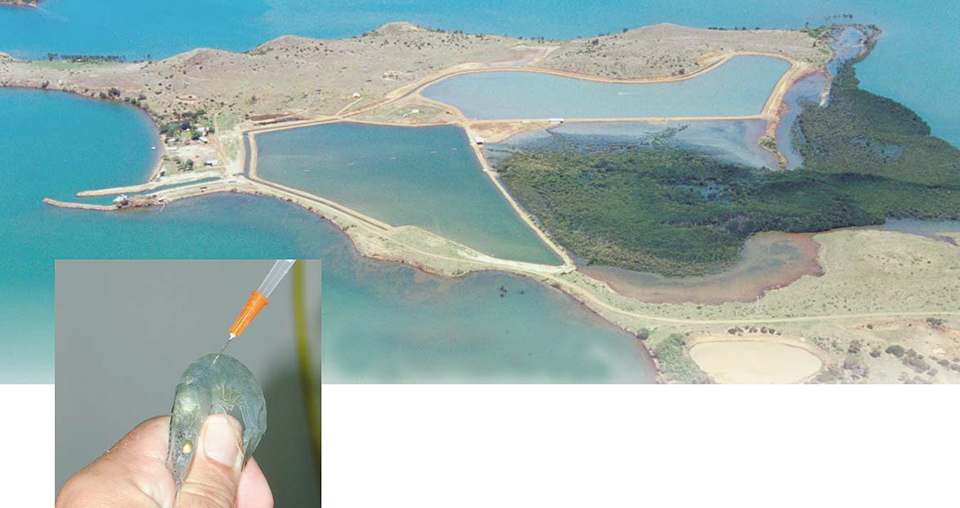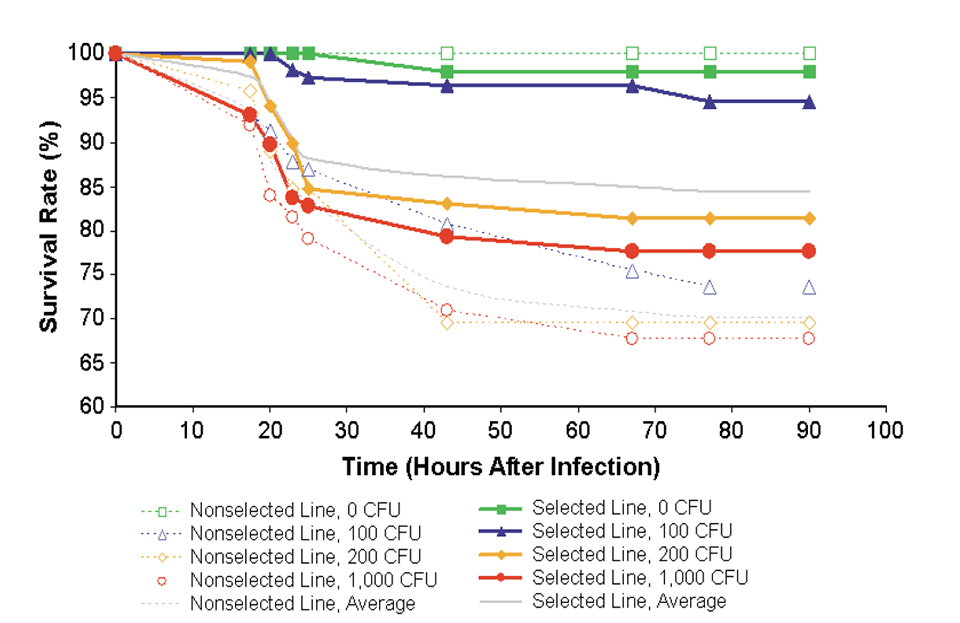Broodstock ponds are little affected by the Vibrio penaeicida bacteria

In New Caledonia, shrimp culture based solely on the Pacific blue shrimp (Litopenaeus stylirostris) represents the second most important export sector for the country. It has a strong social impact, as it generates both regular and seasonal employment in rural areas.
Shrimp production has increased rapidly from 500 metric tons (MT) in 1990 to 2,000 MT in 2000, with a goal of 5,000 MT set for 2005. This despite the fact that since 1993, shrimp survival in New Caledonia ponds is seasonally reduced by the so-called “Syndrome 93” disease.
Caused by the bacteria Vibrio penaeicida, Syndrome 93 is triggered by temperature drops during the passage of cold fronts in winter. Its impact is related to density, and grow-out ponds are more affected than broodstock ponds where the rearing density is traditionally very low. To deal with Syndrome 93, most farmers now produce only during the warm season, which limits industry profitability as processing plants deal with seasonal peaks of production.
Genetic approach to syndrome 93
Shrimp production in New Caledonia is based on closed-cycle broodstock that were successfully domesticated and produced for more than 30 generations despite several bottlenecks. The control of reproduction was not fully mastered at the time when this exotic species was introduced to New Caledonia as a candidate for aquaculture in the 1970s.
The fact that broodstock ponds are little affected by Syndrome 93 may explain that no genetic improvement for survival has risen spontaneously. Therefore, Ifremer, whose shrimp research team is now based at Laboratoire Aquacole de Calédonie at the Bay of Saint Vincent in New Caledonia, is developing a two-way strategy to find a genetic solution to Syndrome 93.
Responding to genetic pressure
The first approach aims at improving the ability of the New Caledonian shrimp stock to respond to new selection pressure. Indeed, microsatellite markers have demonstrated that 90 percent of the allelic diversity available in the wild has been lost in the New Caledonian stock during domestication, which should limit the response to any selective pressure on the present stock.
Inbreeding and genetic diversity have often been studied in aquaculture stocks, but limited data is available on strategies to reintroduce diversity in a given aquaculture stock. Most aquaculture industries are based either on an indigenous species or feral stocks of introduced species (cupped oysters, salmonids) because the genetic resource is generally directly available and exploitable with a very low zoosanitary risk. In contrast, very few aquaculture industries are based exclusively on broodstock domesticated for generations independently from wild or feral broodstock.
Stock introduction
In a more and more difficult global zoosanitary context, two ways of introduction are basically available. One is by introducing animals from the wild, which are more variable than domesticated animals but likely to carry patho-gens and therefore not able to fulfill importation requirements. The other is by introducing domesticated animals with a known sanitary status like the specific pathogen-free (SPF) status awarded to some Hawaiian shrimp lines by the U.S. Department of Agriculture, but which are potentially less variable than wild animals.
The same microsatellite markers used to study the Caledonian stock demonstrated that the L. stylirostris line reared in Hawaii by High Health Aquaculture Inc., the only SPF line of L. stylirostris available, has lost much variability, but the drift that affected the New Caledonian and Hawaiian stocks has not resulted in the loss of the same alleles. In other words, 25 percent of the diversity available in the wild can be restored by mixing the domesticated populations from Hawaii and New Caledonia. Introducing the Hawaiian SPF line in New Caledonia would increase the allelic variability by 150 percent.
This introduction is scheduled for 2004 by shrimp producers, in cooperation with the New Caledonian sanitary authority. The production of a two-way hybrid between the two parental lines, which is a classic breeding strategy in agriculture, will first be tested in a collaboration between the producers and Ifremer before developing a new composite population.
Selective breeding
The second concurrent approach developed by Ifremer to combat Syndrome 93 is to start a selective-breeding program using the available stock. Despite the known high loss of variability, some preliminary results obtained by Ifremer on selection for growth rate demonstrated that some variability was still selectable among Tahitian stock, which are closely related to the New Caledonian animals. The data suggested an assessment of the heritability of survival to V. penaeicida in the available stock, without waiting for the introduction of variability to be completed.
For three generations, an experimental line was developed by mating animals that survived Syndrome 93 episodes during the first six months of their lives in commercial-type grow-out ponds. Shrimp were initially stocked at densities of 20 to 25 postlarvae per square meter. At each generation, the selected animals were then reared at densities of 1 to 2 shrimp per square meter, to be reproduced upon reaching 12 months. A non-selected control line was maintained in parallel by mating animals reared in unaffected “traditional” broodstock ponds with initial densities of 2 postlarvae per square meter.
In both lines, inbreeding was managed by the use of tags which avoided mating close relatives. In order to assess the realized genetic improvement, the third generations of both lines were pregrown separately up to 1 gram, tagged by injection of a colored elastomer, and then mixed in common earthen commercial-type grow-out ponds.
At an average weight of 5 grams, 235 individuals of each line were caught, mixed, and transferred into 16, 200-liter tanks to be challenged by intramuscular injection of V. penaeicida at four different concentrations. The animals in four tanks were treated at 100 colony-forming unit per shrimp, four tanks at 200 colony-forming unit per shrimp, and four tanks at 1,000 colony-forming unit per shrimp. Shrimp in four additional tanks were injected with sterile seawater.
Ongoing results
Intermediate and final mortality were checked in each tank 90 hours after injection. The results are summarized in Fig. 1. Survival was significantly higher for the selected line at the three infection concentrations. On average, survival rates of the infected nonselected and selected animals were 70 percent and 84 percent, respectively, showing a significant improvement of 20 percent in the number of surviving animals (P < 0.01).

In late 2003, the fourth generations of the control and selected lines were produced to confirm these results and compare the lines from physiological and immunological points of view. The methodology of selection could then be transferred to the producers and developed on the Hawaiian stock when it is introduced.
Improved management of genetic variability through the controlled introduction of domesticated genetic diversity will likely allow the year-round production of high-quality New Caledonian blue shrimp.
(Editor’s Note: This article was originally published in the April 2004 print edition of the Global Aquaculture Advocate.)
Now that you've finished reading the article ...
… we hope you’ll consider supporting our mission to document the evolution of the global aquaculture industry and share our vast network of contributors’ expansive knowledge every week.
By becoming a Global Seafood Alliance member, you’re ensuring that all of the pre-competitive work we do through member benefits, resources and events can continue. Individual membership costs just $50 a year. GSA individual and corporate members receive complimentary access to a series of GOAL virtual events beginning in April. Join now.
Not a GSA member? Join us.
Authors
-
Emmanuel Goyard
Ifremer
Laboratoire d’Aquaculture de Nouvelle Calédonie
BP 2059, 98846 Nouméa Cedex
New Caledonia -
Jean-Marie Peignon
Ifremer
Laboratoire d’Aquaculture de Nouvelle Calédonie
BP 2059, 98846 Nouméa Cedex
New Caledonia -
Vincent Vonau
Ifremer
Laboratoire d’Aquaculture de Nouvelle Calédonie
BP 2059, 98846 Nouméa Cedex
New Caledonia -
Cyrille Goarant
Ifremer
Laboratoire d’Aquaculture de Nouvelle Calédonie
BP 2059, 98846 Nouméa Cedex
New Caledonia -
Frédéric Imbert
Ifremer
Laboratoire d’Aquaculture de Nouvelle Calédonie
BP 2059, 98846 Nouméa Cedex
New Caledonia -
Dominique Pham
Ifremer
Laboratoire d’Aquaculture de Nouvelle Calédonie
BP 2059, 98846 Nouméa Cedex
New Caledonia -
Jacques Patrois
Ifremer
Laboratoire d’Aquaculture de Nouvelle Calédonie
BP 2059, 98846 Nouméa Cedex
New Caledonia
Tagged With
Related Posts

Health & Welfare
Dangers of viral pathogens in translocated shrimp, Part 1
Translocated shrimp have the potential to carry pathogens to new areas. Shrimp have a tendency to carry persistent infections without showing signs of disease.

Health & Welfare
Alfalfa concentrate: natural shrimp color enhancer
Adding alfalfa concentrate containing natural carotenoids and pigments to the finishing diets of shrimp can enhance coloration of shrimp after cooking.

Health & Welfare
New management tools for EHP in penaeid shrimp
Authors examined the histological features from shrimp infected with the emerging microsporidian parasite Enterocytozoon hepatopenaei (EHP). A PCR assay method was used to detected in hepatopancreatic tissue, feces and water sampled from infected shrimp tanks, and in some samples of Artemia biomass.

Health & Welfare
The microsporidium <i>Perezia</i> sp. and cotton shrimp disease
Study analyzes samples of microsporidia-infected shrimp in Madagascar, Mozambique and Saudi Arabia and with clinical signs of cotton shrimp disease.


